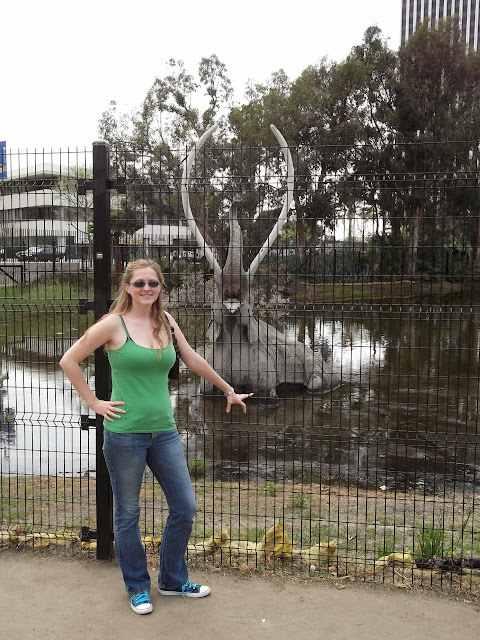La Brea Tar Pits: Museum and Park
My first interaction with the La Brea Tar Pits was in the late 90s movie Volcano. As a geologist now, that movie makes me roll my eyes, but I am thankful for the interest that movie sparked in me about this natural wonder in urban Los Angeles. Tar has been seeping up in the area of the La Brea Tar pits (now Hancock Park) for tens of thousands of years, and all that time animals have been getting stuck and dying in the bubbling pools. Now scientists actively excavate the treasure trove of well preserved fossils buried beneath the tar.
 |
| An actively-bubbling tar pit at La Brea featuring a trapped mammoth statue. |
A vist to the tar pits consists of three attractions in my mind. The first is viewing the pits which have been left unexcavated in their natural state, well natural except for the statues of trapped animals in them. These pools actively bubble as methane gas releases to the atmosphere. Looking at these statues, it is easy to see why Dire Wolves are the most common skeleton discovered in the pits. The wolves constantly fell prey to the pits as they preyed on the helpless animals stuck in the quicksand-like tar. Walking around Hancock Park is free, but it only takes up so much time. The best part of visiting the pits is the Page Museum, also located in the park.
 |
Mammoth fossils recovered from the tar pits on display in the museum.
|
The Page Museum is one of my favorite natural history museums, right along side the Museum of Science and History in Chicago and the National Museum of Natural History in Washington D.C. The Page museum not only is home to a rather extensive fossil collection of some of my favorite creatures (mammoths, saber tooth cats, and ground sloths), it is relatively affordable at lest than $15 for an adult. Room after room is filled with fossils and the history of the tar pits. My favorite exhibit was a wall of over 400 backlit Dire Wolf skulls, meant to drive home the abundance of this animal found in the tar pits. Many times when I see fossils in a museum there are one or two full skeletons of a species, that's it. This was the first time I have seen so many fossils of a single species. The exhibit has a second purpose, to allow visitors to view the differences in the underlying bone structure of a spies, not something easily accomplished with one or tow skeletons. Conversely only one human set of remains has ever been discovered in the tar pits, a woman. I think this shows how much intelligence assists in the survival of a species.
 |
| The impressive backlit display of Dire Wolf skulls in the Page Museum. |
When I visited the Page I was so excited and hyped up about the experience, I spent way too much money on the bottle of water that was supposedly melted from a chunk of ice cut out of a glacier in the gift shop. It tasted gross. Don't be me and skip that water.
 |
| The view from an area where we watched active excavation of a tar pit. |
The last part of visiting the tar pits lies in returning to Hancock Park to view a tar pit actively being excavated. While we were there, we saw two workers reenforcing the walls the pits with wooden boards. Tar constantly seeps in the sides through the cracks in the wood paneling, requiring constant attention. While not the most exciting part of my visit, I liked the reminder to everyone that science is not always awesome discoveries. Behind the scenes is a lot of repetitive, tiresome work, in unforgiving conditions.




No comments:
Post a Comment